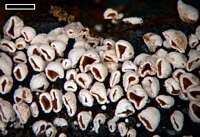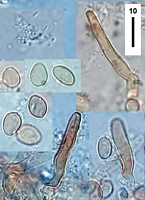|
 Phaeosolenia densa Phaeosolenia densa
SynonymsCyphella densa
Cyphella cupuliformis
BiostatusPresent in region - Indigenous. Non endemic
Images (click to enlarge)
Caption: FUNNZ photo. Scale = 1mm
Owner: J.A. Cooper | 
Caption: hairs and spores.
Owner: J.A. Cooper |
Article: Cooke, W.B. (1961). The cyphellaceous fungi. A study in the Porotheleaceae. Beihefte zur Sydowia 4: 144 p.
Description: Receptacles white to greyish with brownish to vinaceous undertones, 0,1-1,5 mm. long,
cylindric, sessile to short-stipitate, cupshaped to urceolate or tubular, 0,1-0,7 mm. in diameter
when dry, to 2 mm. in diameter when fresh, gregarious to scattered; with an evanescent,
brown subiculum; context hyphae 1,5-3 µ in diameter, with clamp connections, producing
two palisades both arising directly from the context hyphae ; surface hairs produced in one
palisade, brown, stiff, branched below, straight above, perpendicular to the surface or pointed
upward and incurved toward the cup margin, covering the hymenium when dry, incrusted
with crystals up to 2 µ long by 1 µ in diameter, easily removed in mounting, revealing the
thin- to thick-walled, non-septate, brown hairs 20-100-(250) x 3,5-7 µ, with pointed tips;
hymenium produced as the internal palisade, composed only of tightly packed basidia; basidia
(18)-23-40 x 4-(7,5)-9 µ 4-sterigmate, with clamps at the base; spores pale yellow brown to
brown, smooth, apiculate, ovate to subglobose, ellipsoid or almond-shaped or lemon-shaped,
flattened on one side (but not strongly so), (5)-8,5-10,5-(11) x (3)-4,5-5,5-(7,0) µ, or 3-6 µ in
diameter.
Habitat: Habitat: On dead materials of such plants as: Alangium bignoniaefolium, Arenya
saccharifolia, Astonia scholaris, Chusquea sp., Discoxylum hexandrum, Euphorbia sp.,
Ficus sp., F. hawili, Erythrina tomentosa, Fraxinus sp., F. excelsior, Hibiscus sp., Ilex
paraguayensis, Manihot utilissima, M. caragenensis, Paromynia, Pelargonium sp.,
Phytolacca dioica, Pircunia dioica, Populus angustifolia, P. deltoides, Robinia
pseudacacia, Schefflera odorata, Schyzolobium sp., Tectona grandis, Theobroma cacao,
Vitis sp.
Notes: It is possible that Cyphella microthele Speg. belongs in this complex. The type was collected
in Argentina at Entre Rios in Jan. 1902 by C. Spegazzini. It was found on Chloris
distichophylla. Spegazzini's notes indicate that the spores were smooth, fulvous, 5-6 x 5 µ,
produced on basidia 15-18 x 6-7 µ with surface hairs hyaline to fulvous, incrusted, 50-150 x
5-6 µ. No material was found in the type packet loaned by Dr. Lindquist of (LPS) so that the
exact position of this species must remain uncertain.
The combination Phaeocarpus hibisci Pat. appears on herbarium packets (FH) but has not
been found in published form.
Cyphella variolosa Kalchbr. may be distinguished from P. densa by the ovate rather than
almond-shaped spores which are slightly larger, and the surface hairs which form a rather
regular palisade and which are granule-incrusted but whose granules are not present in such
large quantities as in P. densa. Also clamps are present at the base of many of the surface
hairs. However, these differences are rather superficial and non-critical so that specimens
assigned to this species are now added to P. densa.
|